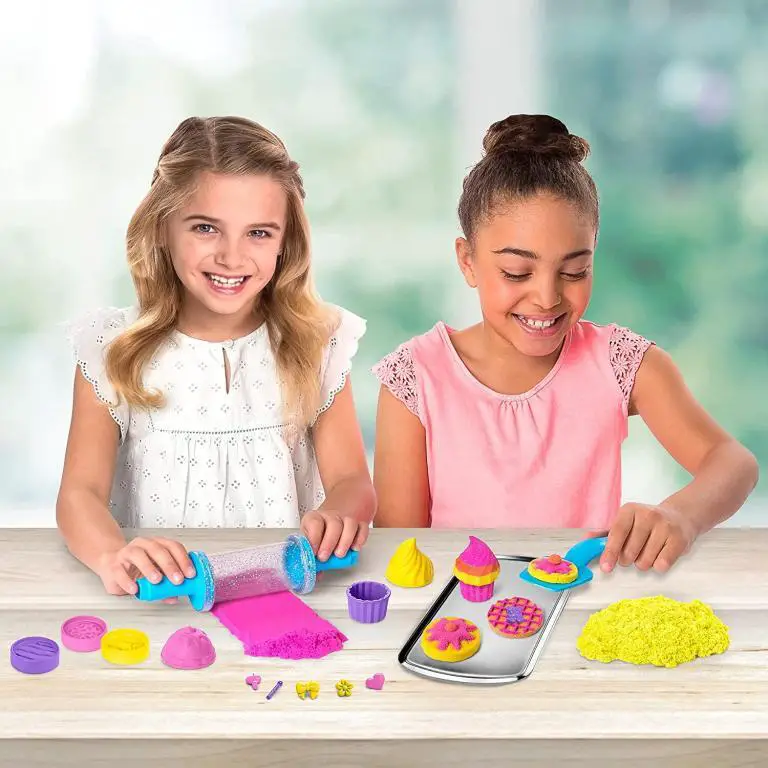
What Happens If You Eat Kinetic Sand?
What Happens If You Eat Kinetic Sand?
What happens if you eat kinetic sand? Many people are asking this question, and it is a valid one. After all, kinetic sand is made of tiny particles that can easily be ingested.
We will explore the answer and look at what happens when you eat
other types of sand. So, What Happens If You Eat Kinetic Sand? Keep reading to find out!
Table of Contents
What Is Kinetic Sand?
Kinetic sand is constructed of tiny round particles. When it’s moved, its kinetic energy causes the sand particles to stick together. This feature makes it moldable and easy to work with.
When it is wet, it takes on the properties of a liquid, and when it is dry, it becomes a solid.
It contains chemicals in small amounts. It consists of 98% sand and 2% polydimethylsiloxane (polymer), which is also known as dimethicone and is found in diaper rash cream, a variety of cosmetics, etc.
What Are The Benefits of Kinetic Sand?
Kinetic sand benefits include the following:
- You can clean easily with a vacuum cleaner or by any other means (same as cleaning regular sand). And if your kids play with play-doh, note that it’s easier to clean kinetic sand than cleaning Play-doh!
- It helps improve hand-eye coordination.
- It helps improve fine motor skills.
- It helps enhance sensory play and elevates childrens’ sensory awareness.
- It is calming and soothing for younger children and adults alike and enables emotional development.
- Young children can create sculptures and other works of art.
As you can see, kinetic sand has many benefits that make it an excellent choice for both children and adults. It’s so much fun to use and helps improve various skills.
Plus, it is calming and soothing, making it an excellent choice for those who need to relax.
So, What Happens If You Eat Kinetic Sand?
Well, the good news is that kinetic sand is non-toxic. It’s only dangerous when eaten in large quantities, and eating a small amount of it is considered safe.
It would be better if your child did not eat large amounts of kinetic sand because it can cause gastrointestinal issues. As with all toys, small children under the age of 3 should be supervised while playing with kinetic sand due to the choking hazard. For older children, it’s considered safe!
Now that we have our main question, “What happens if you eat kinetic sand?” let’s examine what happens when you eat other types of sand.
When you eat ordinary beach sand, your body will try to get rid of it as quickly as possible. This is because regular sand is not meant to be ingested. It can cause many gastrointestinal issues such as vomiting and diarrhea.
When you eat kinetic sand, it will travel down your throat and into your stomach. Once it reaches your stomach, the sand will start to dissolve.
This is because your stomach has a high level of acidity that can break down the particles in the sand. Once the particles have dissolved, they will be absorbed into your bloodstream. They will travel to all of the other organs in your body.
The sand will start to take effect almost immediately. It will first affect your digestive system. The sand will cause your stomach to produce more acid, which will, in turn, cause you to feel nauseous.
You may also experience vomiting and diarrhea. The sand will also start to affect your lungs. It will cause you to have difficulty breathing, which may even lead to pneumonia.
The sand will also start to affect your brain. It may cause you to feel dizzy and confused and experience seizures or even a coma. In extreme cases, the sand may even lead to death.
As you can see, eating kinetic sand is not a good idea. It can have severe consequences for your health. So, What Happens If You Eat Kinetic Sand? The answer is pretty straightforward – it can make you very sick!
What Are The Potential Risks Associated With Eating Kinetic Sand? Are They Worth The Risk?
Kinetic sand can be fun to play with, but is it safe to eat?
The short answer is no – kinetic sand should not be eaten in any quantity. While eating kinetic sand may not have severe consequences for everyone, some potential risks are associated with consuming it.
These risks include gastrointestinal issues such as vomiting and diarrhea, difficulty breathing, pneumonia, and even death.
What Are The Benefits of Kinetic Sand Compared to Other Types of Sand Play Materials?
Kinetic sand, uniquely, has both liquid and solid properties. This means that wet sand can be molded into different shapes, and it will hold its shape when it dries. Kinetic sand is also non-toxic, meaning that it is safe for kids to play with. It can be used to create sculptures, buildings, and other structures.
Other types of sand play materials, such as beach sand or sandbox sand, are not as versatile as kinetic sand, and they can often contain small rocks or other objects that can cause injuries. Normal sand can also be dusty and difficult to clean up.
Sandbox sand often contains bacteria and other germs. Kinetic sand does not have these problems, making it a safer and more sanitary option for play sand.
Kinetic sand is also an excellent tool for developing fine motor skills. Kids can use it to create intricate designs and patterns. The sand will hold its shape once it dries so that kids can keep their creations forever. Kinetic sand is available in different colors, which allows for even more creative possibilities.
Another interesting read: Best Wooden Play Dough Tools – Playdough Toys
DIY Kinetic Sand - Here is a Great Way!
FAQs: What Happens If You Eat Kinetic Sand?
Q: What Happens If You Eat Kinetic Sand? Is Kinetic San Edible?
It’s unclear what would happen if you ate kinetic sand, as there hasn’t been any research. However, kinetic sand is tested and found to be safe for all required safety standards. It’s only dangerous when eaten in large quantities!
It is made of tiny particles of silicone oil, which are too small to be digested by the human body. However, they might get trapped in your digestive system and cause problems. Ingesting large quantities of dust can cause problems like lung infection or pneumonitis, so it’s best to avoid eating kinetic sand altogether.
Q: What Are The Risks of Eating Kinetic Sand?
There haven’t been any studies on what happens if you eat kinetic sand, so it’s hard to say. However, there are some risks associated with ingesting any dust. Inhalation of dust can cause lung infection or pneumonitis, both of which can be serious.
It’s also possible that the tiny particles of silicone oil in kinetic sand could get trapped in your digestive system and cause problems. So far, there hasn’t been any research on this, but it’s best to avoid taking the risk and not eat kinetic sand.
Q: What Would Happen If You Ate a Whole Bag of Kinetic Sand?
It’s impossible to say what would happen if you ate a whole bag of kinetic sand, as no research has been conducted. However, you would likely experience some health problems.
It is made of tiny particles of silicon dioxide, which are too small to be digested by the human body. Ingesting large amounts of dust can cause problems like lung infection or pneumonitis, so it’s best to avoid eating kinetic sand altogether.
Conclusion
So, What Happens If You Eat Kinetic Sand? As of now, there is no concrete evidence of what could happen if you ate kinetic sand.
However, it’s best not to try it, as there are some risks associated with ingesting any dust- including lung infection or pneumonitis. Consuming large amounts of dust can be dangerous, so it’s probably a good idea to avoid eating kinetic sand altogether. Thanks for reading!
See also:
- Kinetic Sand Vs. Play-Doh: Which Is Better For Your Child?
- Does Kinetic Sand Dry Out?
- Is Kinetic Sand Toxic?
- Best Wooden Play Dough Tools – Playdough Toys
- Best Toys to Help Toddlers Talk – Development Speech
- Can Kinetic Sand Get Wet?
- Is Kinetic Sand Biodegradable?
- Why Is My Kinetic Sand Sticking To My Hands?
- Is Kinetic Sand Magnetic?


Comments are closed.